Samain Thanksgiving Moon

Into On the Move Fitness for a new workout: side lunges on the TRX, oblique isometrics with bands, a twisting shoulder press, planks, stepups with weight, push ups from an exercise ball, crunches on an exercise ball.
I always feel so much better when I exercise routinely. Long ago I decided regular exercise was a matter of identity. Am I an exerciser, or not? Once I decided I was an exerciser I’ve been able to maintain regular exercise. When I fall away after a chaotic schedule or a long trip, I remind myself, I’m an exerciser. Then I start again.
Working on color field paintings. Finding myself looking, seeing, in a whole different way. For example when Kate and I were on our way to the radiologist Wednesday as dawn broke, I saw the color bands in the sky as inspiration for painting. Began wondering how to mix paints to get that color, how to arrange those colors on a canvas. Yesterday at On the Move I noticed a droopy face in the wood grains of a bathroom door. Oh, I could do that! While I did my cardio I wondered about the deep blue wall. Could I just cut a rectangle out of the sheet rock, frame it and call it found art?
 My friends Stefan and Lonnie have devoted the last three years to a traditional painting education. The atelier in Florence where they’ve studied makes the usual atelier argument that representational painting is real painting, the sharp turn taken by Cezanne, Monet, Van Gogh and later DuChamp, ManRay, Bacon, Pollock, Rothko a mistake.
My friends Stefan and Lonnie have devoted the last three years to a traditional painting education. The atelier in Florence where they’ve studied makes the usual atelier argument that representational painting is real painting, the sharp turn taken by Cezanne, Monet, Van Gogh and later DuChamp, ManRay, Bacon, Pollock, Rothko a mistake.
I’ve always felt that an argument over “true” art is doomed at the beginning. I’m more a DuChampian, art is what an artist makes. That means, at least to me, that the color field painters, the pop artists, the abstract painters, fluxus folks, are making art. It also means that those still creating representational art are making art. Why fight?
My interest, at least right now, is in color, just color, arranging it on a flat surface in a pleasing or provocative or evocative way. I intend to make abstract works inspired by nature. The shape and color and texture of mountains at different times of day. The sky at sunrise and sunset. The night sky, especially moons. Streams. Faces in wooden doors. Clouds. I’ve noticed for a long while that even the most Rococo flourishes are often direct copies of natural forms. Not sure where this will take me, but I’m really enjoying the enhanced seeing, the thoughts about color, the mix of brushes and paints and palette knives.

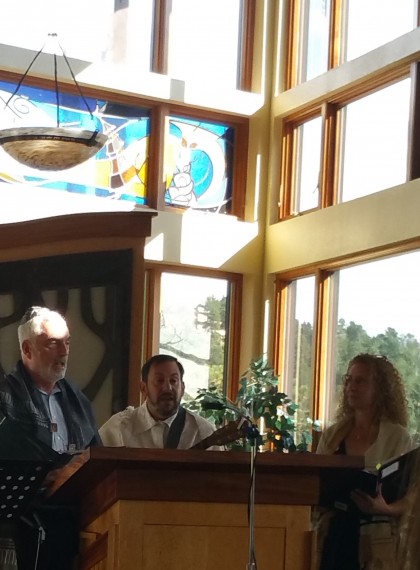
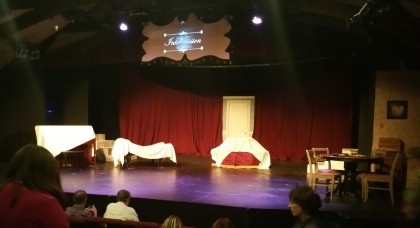
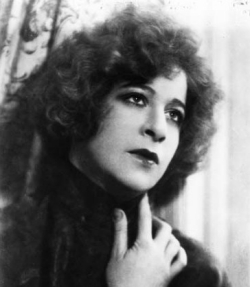
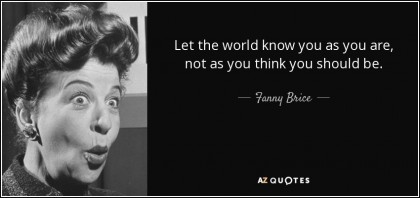 We knew people in the cast, saw folks we knew in the lobby, and were greeted by the costumer as we left. He remembered us from our visit to the tech rehearsal. In other words this was also a moment of immersion in community, our community. That’s not the same as a visit to the Guthrie or to Broadway, but has lots of other, ancillary benefits.
We knew people in the cast, saw folks we knew in the lobby, and were greeted by the costumer as we left. He remembered us from our visit to the tech rehearsal. In other words this was also a moment of immersion in community, our community. That’s not the same as a visit to the Guthrie or to Broadway, but has lots of other, ancillary benefits.
 Just before getting up this morning a strange, but somehow obvious thought occurred to me. While on the backstage tour we visited the dresser, an energetic guy who made or altered 490 costumes for the women in this performance. !. We saw the multiple props, a day bed, a drinks trolley, several doors with wheels, a set of steps for musical numbers, a kitchen table, a dressing table. Downstairs we saw the storage areas for costumes and prop making materials. We spoke with the dresser, the stage manager, the director, the actors, several of them, the lighting and sound people. All, to a person, warm and friendly.
Just before getting up this morning a strange, but somehow obvious thought occurred to me. While on the backstage tour we visited the dresser, an energetic guy who made or altered 490 costumes for the women in this performance. !. We saw the multiple props, a day bed, a drinks trolley, several doors with wheels, a set of steps for musical numbers, a kitchen table, a dressing table. Downstairs we saw the storage areas for costumes and prop making materials. We spoke with the dresser, the stage manager, the director, the actors, several of them, the lighting and sound people. All, to a person, warm and friendly. Here’s the thought. Going backstage, seeing all the accoutrements for staging a play, especially going into the basement area, made me think of id, ego and superego. Of the masks and personas we wear. Of our brain as backstage, where we store props, costume changes, makeup, where we put together the elements of the show that is our lives. The show itself, and its superego, the director, is the life others see, the one we present as we strut and fret our hour upon the stage, then are heard no more.
Here’s the thought. Going backstage, seeing all the accoutrements for staging a play, especially going into the basement area, made me think of id, ego and superego. Of the masks and personas we wear. Of our brain as backstage, where we store props, costume changes, makeup, where we put together the elements of the show that is our lives. The show itself, and its superego, the director, is the life others see, the one we present as we strut and fret our hour upon the stage, then are heard no more.

 Why are we so reluctant to recognize that racism, sexism, homelessness, income inequality, white fear are the result of decisions we’ve made collectively and individually? I think the answer lies in ideas Arthur Brooks identifies as the bedrocks of conservative thought. Below is a portion of that article,
Why are we so reluctant to recognize that racism, sexism, homelessness, income inequality, white fear are the result of decisions we’ve made collectively and individually? I think the answer lies in ideas Arthur Brooks identifies as the bedrocks of conservative thought. Below is a portion of that article,  But, to sacralize that unique reality, “…conservatives have always placed tremendous emphasis on the sacred space where individuals are formed.” says Brooks, serves to deny its perniciousness, its damning of so many to lives of desperation, marginalized from both economic and cultural blessings. Once we emerge in the era, the family, the town or neighborhood or rural place, the religious or areligious space gifted to us, the nation of our birth, once we are over being thrown into circumstances beyond our volition, we gain the power of choice.
But, to sacralize that unique reality, “…conservatives have always placed tremendous emphasis on the sacred space where individuals are formed.” says Brooks, serves to deny its perniciousness, its damning of so many to lives of desperation, marginalized from both economic and cultural blessings. Once we emerge in the era, the family, the town or neighborhood or rural place, the religious or areligious space gifted to us, the nation of our birth, once we are over being thrown into circumstances beyond our volition, we gain the power of choice.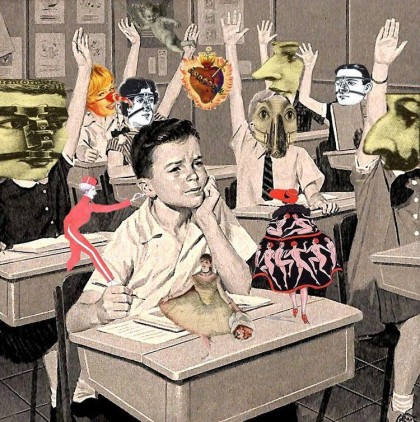 Back in the day, the now further and further away day, I always went to class. I might have missed a few, but it was rare. I enjoyed learning from lectures, getting in the mix of dialogue, thinking out loud. Last night I was the only student in the qabbalah class on Time.
Back in the day, the now further and further away day, I always went to class. I might have missed a few, but it was rare. I enjoyed learning from lectures, getting in the mix of dialogue, thinking out loud. Last night I was the only student in the qabbalah class on Time. Being human is a daunting task, steeped in misdirection, existential isolation, perception clouded by tradition, by language, even by our body. Qabbalists and taoists and ch’an buddhists have worked, hard, to peel the onion of our awareness. They are subtle, in their own way as subtle as particle physics or genetics or neuroscience, attempts to understand this task, the one none of us can jettison, save through suicide. They differentiate from the narrowing tendency of science by insisting on a full, a comprehensive positioning of this strange creature that we are in the wild.
Being human is a daunting task, steeped in misdirection, existential isolation, perception clouded by tradition, by language, even by our body. Qabbalists and taoists and ch’an buddhists have worked, hard, to peel the onion of our awareness. They are subtle, in their own way as subtle as particle physics or genetics or neuroscience, attempts to understand this task, the one none of us can jettison, save through suicide. They differentiate from the narrowing tendency of science by insisting on a full, a comprehensive positioning of this strange creature that we are in the wild. Thought experiments like taoism, qabbala, ch’an or zen buddhism try to shock us out of our stupor, the life lived without seeing the wilderness for what it is, the life lived within the conventions of a particular time, a particular language, a particular place, a life lived without knowing what life is. Most people find little reason to peak behind the curtain of this emerald city that we think is what is. The apparent life, the one with family and money and the NFL and food and houses and sunlight and night, seems to be all that could be. We do not question, we try to paddle the little barque of our body on this river (life) often using only our hands over the edge of the boat.
Thought experiments like taoism, qabbala, ch’an or zen buddhism try to shock us out of our stupor, the life lived without seeing the wilderness for what it is, the life lived within the conventions of a particular time, a particular language, a particular place, a life lived without knowing what life is. Most people find little reason to peak behind the curtain of this emerald city that we think is what is. The apparent life, the one with family and money and the NFL and food and houses and sunlight and night, seems to be all that could be. We do not question, we try to paddle the little barque of our body on this river (life) often using only our hands over the edge of the boat. And yet there is more, not more in the sense of more layers or more depth, for those layers and depths, the wilderness, always surround us, are the water to which we are the fish, but more in terms of what we can know, what we can access, what we can use to help us become awake. Woke, in the current vernacular, not woke to racism and sexism and oppression in this instance, but woke to the true majesty and wonder of life itself, of this wilderness journey, this most ancient of ancientrails.
And yet there is more, not more in the sense of more layers or more depth, for those layers and depths, the wilderness, always surround us, are the water to which we are the fish, but more in terms of what we can know, what we can access, what we can use to help us become awake. Woke, in the current vernacular, not woke to racism and sexism and oppression in this instance, but woke to the true majesty and wonder of life itself, of this wilderness journey, this most ancient of ancientrails.
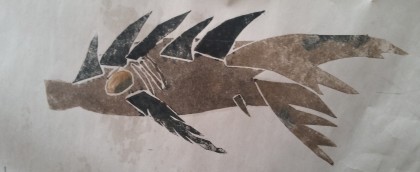




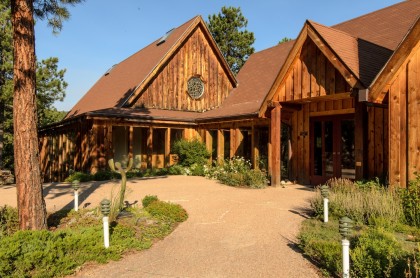 Irv Saltzman invited us to a performance by his singing group, the Renaissance Singers. It was held in a wooden Episcopal Church, St. Laurence’s, which is near our home. Directed by a Chinese national, Hannah Woo, who is finishing her Ph.D. in musicology, they were 8, four men and four women. As a group, they matched each other well. April, a soprano, had a lovely clear voice and a large range. Irv, formerly a tenor, has now transitioned into a bass/baritone role. Their performance was wonderful. At a meal afterwards we discovered April is our neighbor.
Irv Saltzman invited us to a performance by his singing group, the Renaissance Singers. It was held in a wooden Episcopal Church, St. Laurence’s, which is near our home. Directed by a Chinese national, Hannah Woo, who is finishing her Ph.D. in musicology, they were 8, four men and four women. As a group, they matched each other well. April, a soprano, had a lovely clear voice and a large range. Irv, formerly a tenor, has now transitioned into a bass/baritone role. Their performance was wonderful. At a meal afterwards we discovered April is our neighbor. Renaissance choral music and instrumental renaissance music has always captivated me. It’s easy to see courtiers in colorful costumes listening to this music in a palace, brown robed and cowled monks hearing it in a morning prayer service, or small groups performing at home for their own amusement. It’s also the music most often heard at Renaissance festivals. Sorta makes sense, eh?
Renaissance choral music and instrumental renaissance music has always captivated me. It’s easy to see courtiers in colorful costumes listening to this music in a palace, brown robed and cowled monks hearing it in a morning prayer service, or small groups performing at home for their own amusement. It’s also the music most often heard at Renaissance festivals. Sorta makes sense, eh?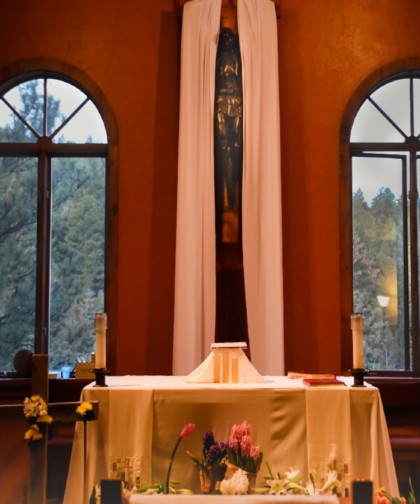 Between the two windows hung a large crucifix, a cross made of bare, light wood and a bronze Jesus hung by two nails. I had an odd sensation while listening to this music I’ve often heard in monastic settings on retreat. It carried me back into the spiritual space of an ascetic Christianity that often comforted me. This time though I came into the space as a peri-Jew, identifying more with Marilyn and Irv and Kate, with the still new to me spiritual space of Beth Evergreen, than the theological world represented by this spare, but beautiful sanctuary.
Between the two windows hung a large crucifix, a cross made of bare, light wood and a bronze Jesus hung by two nails. I had an odd sensation while listening to this music I’ve often heard in monastic settings on retreat. It carried me back into the spiritual space of an ascetic Christianity that often comforted me. This time though I came into the space as a peri-Jew, identifying more with Marilyn and Irv and Kate, with the still new to me spiritual space of Beth Evergreen, than the theological world represented by this spare, but beautiful sanctuary.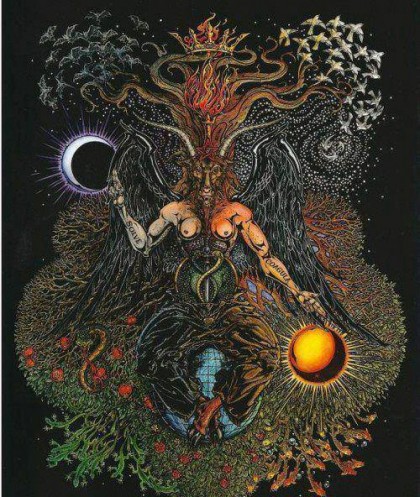 This was an afternoon filled with the metaphysical whiplash I’ve experienced often over the last year, a clashing of deep thought currents, spiritual longings. This process is a challenge to my more recent flat-earth humanism, a pagan faith grounded not in the next world, but in this one. Literally grounded.
This was an afternoon filled with the metaphysical whiplash I’ve experienced often over the last year, a clashing of deep thought currents, spiritual longings. This process is a challenge to my more recent flat-earth humanism, a pagan faith grounded not in the next world, but in this one. Literally grounded.